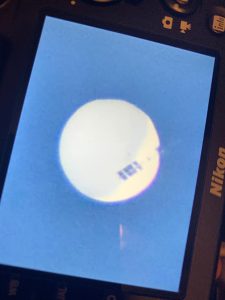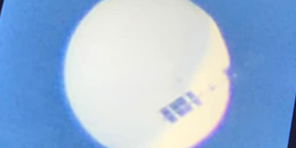By Don Pritchard STE. GENEVIEVE — My phone rang about 4:15 p.m. Friday. It was state legislator Dale Wright, calling to tell me a suspected Chinese spy balloon was overhead.
STE. GENEVIEVE — My phone rang about 4:15 p.m. Friday. It was state legislator Dale Wright, calling to tell me a suspected Chinese spy balloon was overhead.
Linda was already halfway out the door, as she was letting our dog out and she spotted it easily.
I joined her and sure enough the globe was a brilliant white against the blue Missouri sky.
Of course, I, like most Americans had heard about the balloon which was first reported over Montana. It was floating at about 60,000 feet going in a southeast direction at about 75 miles an hour according to reports.
I snapped a few photos with my cellphone camera which of course didn’t do it justice.
Later someone posted a much, much better photo to Facebook.
As I stood barefoot in the street I called out to my neighbors to witness this unusual event. No one responded. One of my neighbors drove by as I pointed frantically toward the sky. They didn’t slow down.
There was much more interest on social media.
The Chinese government said the balloon was a civilian project which went off course due to strong winds.
No one accepted that explanation and it was the general consensus that it was a spy balloon gathering intel on our nuclear tipped missiles and other military installations.
Many who posted about it on Facebook demanded that the U.S. shoot the thing down. That prompted some to express concerns about what would happen when the large equipment rack hanging underneath the balloon struck the ground, possibly causing casualties and property damage.
Eventually the balloon drifted eastward and was over the Atlantic Ocean about six miles off the coast.
An American fighter jet then used a missile to bring it down and at press time divers were attempting to located the wreckage in 47-feet of water.
China immediately protested the shoot down and promised some sort of retaliation.
It’s not the first time balloons have floated from Asia to America.
During World War II the Japanese Empire launched balloons laden with explosives. Some reached the west coast of America and there were reports of minor forest fires being ignited by the balloons. (It would have been a different story had their been a drought that year. But the forests were very moist.) There were 9,300 built and of those, 300 made it to the U.S., Canada or Mexico. There were six deaths associated with the balloon bombs.
Many of the bombs did not go off when they hit the ground. The remains of the balloon bombs were found in the forests for decades after the war. In 2014 one was found in British Columbia and was detonated by a Royal Canadian Navy ordinance disposal team. Another was found in 2019, also in British Columbia.
Ham radio enthusiasts in several nations regularly launch balloons on high altitude flights and endurance flights around the world. These are small balloons with electronic equipment on board that broadcast location information.
Eventually we will probably find out just what kind of equipment the balloon was carrying. We may even obtain ironclad proof of its purpose.
It is possible there are more balloons being launched in China. There was a report of another one in Latin America.
Watching the balloon drifting over my house in Ste. Genevieve brought home to me the fact that the world has become smaller. I felt the same way after the launch of Russia’s Sputnik in 1957 when I was only six years old. For the first time I felt vulnerable, very vulnerable, in my home in Whittier Calif. It was not a pleasant feeling then. And it is not a pleasant feeling 65 years later.
Balloon photo by Mike White

